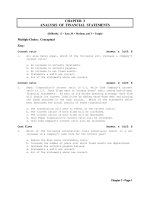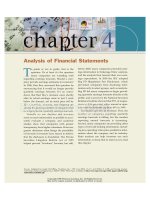Business finance ch 3 analysis of financial statements
Bạn đang xem bản rút gọn của tài liệu. Xem và tải ngay bản đầy đủ của tài liệu tại đây (114.81 KB, 37 trang )
CHAPTER 3
Analysis of Financial
Statements
Ratio Analysis
Du Pont system
Effects of improving ratios
Limitations of ratio analysis
Qualitative factors
3-1
Balance Sheet: Assets
2003E
Cash
85,632
A/R
878,000
Inventories 1,716,480
Total CA
2,680,112
Gross FA
1,197,160
Less: Dep.
380,120
Net FA
817,040
Total Assets
3,497,152
2002
7,282
632,160
1,287,360
1,926,802
1,202,950
263,160
939,790
2,866,592
3-2
Balance sheet:
Liabilities and Equity
2003E
Accts payable
436,800
Notes payable
300,000
Accruals
408,000
Total CL
1,144,800
Long-term debt
400,000
Common stock
1,721,176
Retained earnings
231,176
Total Equity
1,952,352
Total L & E
3,497,152
2002
524,160
636,808
489,600
1,650,568
723,432
460,000
32,592
492,592
2,866,592
3-3
Income statement
2003E
Sales
7,035,600
COGS
5,875,992
Other expenses 550,000
EBITDA
609,608
Depr. & Amort.
116,960
EBIT
492,648
Interest Exp.
70,008
EBT
422,640
Taxes
169,056
Net income
253,584
2002
6,034,000
5,528,000
519,988
(13,988)
116,960
(130,948)
136,012
(266,960)
(106,784)
(160,176)
3-4
Other data
2003E
No. of shares 250,000
EPS
$1.014
DPS
$0.220
Stock price
$12.17
Lease pmts $40,000
2002
100,000
-$1.602
$0.110
$2.25
$40,000
3-5
Why are ratios useful?
Ratios standardize numbers and
facilitate comparisons.
Ratios are used to highlight
weaknesses and strengths.
3-6
What are the five major categories
of ratios, and what questions do they
answer?
Liquidity: Can we make required
payments?
Asset management: right amount of
assets vs. sales?
Debt management: Right mix of debt
and equity?
Profitability: Do sales prices exceed unit
costs, and are sales high enough as
reflected in PM, ROE, and ROA?
Market value: Do investors like what they
see as reflected in P/E and M/B ratios?
3-7
Calculate D’Leon’s forecasted
current ratio for 2003.
Current ratio = Current assets / Current
liabilities
= $2,680 / $1,145
= 2.34x
3-8
Comments on current ratio
Current
ratio
2003
2002
2001
Ind.
2.34x
1.20x
2.30x
2.70x
Expected to improve but still
below the industry average.
Liquidity position is weak.
3-9
What is the inventory
turnover vs. the industry
average?
Inv. turnover = Sales / Inventories
= $7,036 / $1,716
= 4.10x
Inventory
Turnover
2003
2002
2001
Ind.
4.1x
4.70x
4.8x
6.1x
3-10
Comments on
Inventory Turnover
Inventory turnover is below
industry average.
D’Leon might have old inventory,
or its control might be poor.
No improvement is currently
forecasted.
3-11
DSO is the average number of days
after making a sale before receiving
cash.
DSO= Receivables / Average sales per
day
= Receivables / Sales/365
= $878 / ($7,036/365)
= 45.6
3-12
Appraisal of DSO
DSO
2003
2002
2001
Ind.
45.6
38.2
37.4
32.0
D’Leon collects on sales too
slowly, and is getting worse.
D’Leon has a poor credit policy.
3-13
Fixed asset and total asset turnover
ratios vs. the industry average
FA turnover = Sales / Net fixed
assets
= $7,036 / $817 = 8.61x
TA turnover = Sales / Total assets
= $7,036 / $3,497 = 2.01x
3-14
Evaluating the FA turnover
and TA turnover ratios
2003
2002
2001
Ind.
FA TO
8.6x
6.4x
10.0x
7.0x
TA TO
2.0x
2.1x
2.3x
2.6x
FA turnover projected to exceed the
industry average.
TA turnover below the industry
average. Caused by excessive currents
assets (A/R and Inv).
3-15
Calculate the debt ratio, TIE, and
EBITDA coverage ratios.
Debt ratio
= Total debt / Total assets
= ($1,145 + $400) / $3,497 =
44.2%
TIE
= EBIT / Interest expense
= $492.6 / $70 = 7.0x
3-16
Calculate the debt ratio, TIE, and
EBITDA coverage ratios.
EBITDA =
coverage
=
(EBITDA+Lease pmts)
Int exp + Lease pmts + Principal pmts
$609.6 + $40
$70 + $40 + $0
= 5.9x
3-17
How do the debt management
ratios compare with industry
averages?
D/A
TIE
2003 2002 2001
Ind.
44.2% 82.8% 54.8% 50.0%
7.0x
-1.0x
4.3x
6.2x
EBITDA
coverag 5.9x
0.1x
3.0x
8.0x
e
D/A and TIE are better than the
industry average, but EBITDA coverage
still trails the industry.
3-18
Profitability ratios:
Profit margin and Basic earning
power
Profit margin = Net income / Sales
= $253.6 / $7,036 = 3.6%
BEP
= EBIT / Total assets
= $492.6 / $3,497 =
14.1%
3-19
Appraising profitability with the
profit margin and basic earning
power
PM
BEP
2003 2002 2001
Ind.
3.6% -2.7% 2.6% 3.5%
14.1% -4.6% 13.0% 19.1%
Profit margin was very bad in 2002, but is projected to
exceed the industry average in 2003. Looking good.
BEP removes the effects of taxes and financial
leverage, and is useful for comparison.
BEP projected to improve, yet still below the industry
average. There is definitely room for improvement.
3-20
Profitability ratios:
Return on assets and Return on
equity
ROA= Net income / Total assets
= $253.6 / $3,497 = 7.3%
ROE = Net income / Total common
equity
= $253.6 / $1,952 = 13.0%
3-21
Appraising profitability with the
return on assets and return on
equity
ROA
ROE
2003
7.3%
2002 2001
Ind.
-5.6% 6.0% 9.1%
13.0%
13.3% 18.2%
32.5%
Both ratios rebounded from the previous
year, but are still below the industry
average. More improvement is needed.
Wide variations in ROE illustrate the effect
that leverage can have on profitability.
3-22
Effects of debt on ROA and
ROE
ROA is lowered by debt--interest
lowers NI, which also lowers ROA
= NI/Assets.
But use of debt also lowers
equity, hence debt could raise
ROE = NI/Equity.
3-23
Problems with ROE
ROE and shareholder wealth are correlated,
but problems can arise when ROE is the
sole measure of performance.
ROE does not consider risk.
ROE does not consider the amount of capital
invested.
Might encourage managers to make investment
decisions that do not benefit shareholders.
ROE focuses only on return. A better
measure is one that considers both risk and
return.
3-24
Calculate the Price/Earnings,
Price/Cash flow, and Market/Book
ratios.
P/E
= Price / Earnings per share
= $12.17 / $1.014 = 12.0x
P/CF = Price / Cash flow per share
= $12.17 / [($253.6 + $117.0) ÷
250]
= 8.21x
3-25









